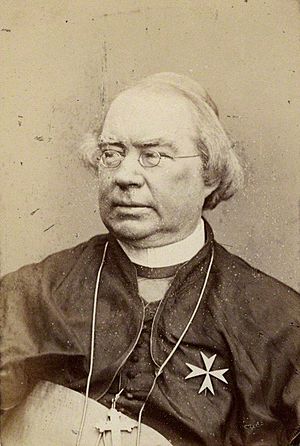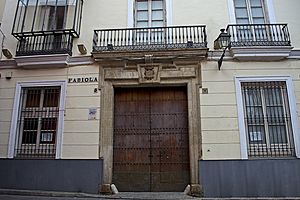Nicholas Wiseman facts for kids
Quick facts for kids His Eminence Nicholas Patrick Stephen Wiseman |
|
|---|---|
| Cardinal, Archbishop of Westminster Primate of England and Wales |
|

Cardinal Wiseman
|
|
| Province | Westminster |
| Diocese | Westminster |
| Appointed | 29 August 1847 (Coadjutor Vicar Apostolic) |
| Enthroned | 29 September 1850 |
| Reign ended | 15 February 1865 |
| Predecessor | Thomas Walsh (as Vicar Apostolic) |
| Successor | Henry Edward Manning |
| Other posts | Cardinal-Priest of Santa Pudenziana |
| Orders | |
| Ordination | 19 March 1825 |
| Consecration | 8 June 1840 by Giacomo Filippo Fransoni |
| Created Cardinal | 30 September 1850 |
| Rank | Cardinal-Priest |
| Personal details | |
| Birth name | Nicolás Patricio Esteban Wiseman |
| Born | 3 August 1802 Seville, Spain |
| Died | 15 February 1865 (aged 62) York Place, Portman Square, London, England |
| Buried | Westminster Cathedral |
| Denomination | Catholic |
| Parents | James Wiseman and Xaviera Wiseman (née Strange) |
| Previous post |
|
| Styles of Nicholas Wiseman |
|
|---|---|
 |
|
| Reference style | His Eminence |
| Spoken style | Your Eminence |
| Informal style | Cardinal |
Nicholas Patrick Stephen Wiseman (born August 3, 1802 – died February 15, 1865) was an important leader in the Catholic Church. He became the very first Archbishop of Westminster when the Catholic Church was officially re-established in England and Wales in 1850. This was a big moment for Catholics in England.
Wiseman was born in Seville, Spain, to Irish parents. He went to school in Waterford, Ireland, and then to Ushaw College in England. Later, he studied at the English College, Rome in Italy, where he eventually became the head (Rector). While in Rome, he gave speeches to English Catholics. He also helped start a magazine called Dublin Review in 1836. In 1840, he became the president of Oscott College in England.
Contents
Early Life and Education
Nicholas Wiseman was born in Seville, Spain, on August 2, 1802. His father, James Wiseman, was a merchant, and his mother, Xaviera (née Strange), was from Waterford, Ireland. His parents had moved to Spain for business.
When his father died in 1805, Nicholas was brought to his parents' home in Waterford, Ireland. In 1810, he was sent to Ushaw College near Durham, where he studied until he was sixteen. He later remembered that John Lingard, a leader at the college, was very kind to him.
In 1818, Wiseman went to the English College in Rome. This college had just reopened after being closed for twenty years because of the Napoleonic Wars. He was a brilliant student and earned a doctorate in theology in July 1824. He became a priest on March 10, 1825.
Early Career in Rome
In 1827, Wiseman became the assistant head (vice-rector) of the English College. The next year, in 1828, he became the head (Rector) of the college, even though he was not yet 26 years old. He held this important job until 1840.
Wiseman loved to study old texts and history. He spent a lot of time looking at old manuscripts in the Vatican library. His first book, Horae Syriacae, published in 1827, showed he was a very promising scholar.
Pope Leo XII (who was Pope from 1823 to 1829) made Wiseman the person in charge of Arabic manuscripts at the Vatican. He also became a professor of Oriental languages at the Roman University.
The Pope also asked him to give speeches to English people living in Rome. His talks, called On the Connexion between Science and Revealed Religion, became very popular. In these talks, he explained that even though science sometimes seemed to disagree with Christian beliefs, further study often showed they could work together. Many people, including a famous critic named Andrew Dickson White, praised Wiseman for being open to science.
Return to England
Wiseman visited England in 1835 and 1836. He gave many lectures about the Catholic faith in London. These lectures were very successful. Even John Henry Newman, a famous Anglican leader at the time, reviewed them positively.
In 1836, Wiseman started the Dublin Review magazine. He wanted to inspire English Catholics and help them feel more connected to the Pope. He also wanted to discuss the Oxford Movement, a group of Anglicans interested in Catholic traditions. Wiseman was known as a smart scholar who knew many languages and was interested in science, art, and history.
In 1839, an article by Wiseman about an old Christian disagreement called the Donatist schism caught the attention of people at Oxford. They saw similarities between this old problem and the situation of Anglicans. In 1840, Wiseman became a bishop and was sent to England. He became the coadjutor (assistant) to Bishop Thomas Walsh and also the president of Oscott College near Birmingham.
Leading Oscott College
Under Wiseman's leadership, Oscott College became a very important place for English Catholics. Many people who converted to Catholicism from the Oxford Movement came to Oscott. Wiseman helped these new converts, many of whom had no money. He also helped Newman and his friends go to Rome to study before starting their church work in England.
Later, Wiseman became the coadjutor to Bishop Walsh in the London area. When Bishop Walsh died in 1849, Wiseman took over his role permanently.
In 1847, Wiseman also acted as a special messenger from the Pope to the English government. He wanted to see if England would help the Pope with his plans for change. He worked hard to help Catholic criminals and poor people return to their faith. He also encouraged the creation of new religious groups for men and women. In 1848, he gave a famous speech at the opening of St George's Cathedral in Southwark. This was a very special event, with many bishops and priests attending.
Becoming a Cardinal

Catholicism was growing in England, but Wiseman faced some challenges from a few of his own clergy. They did not like his "Romanizing" ideas, such as bringing more sacred images into churches and encouraging devotions to the Blessed Virgin Mary.
In July 1850, Wiseman learned that the Pope wanted to make him a cardinal. He thought this meant he would stay in Rome. But when he arrived, he found out that the Pope wanted him to return to England as a cardinal and the first Archbishop of Westminster.
The Pope's official letter, Universalis Ecclesiae, which set up the new Catholic leadership in England, was dated September 29, 1850. Wiseman wrote a letter to the English people, dated October 7, 1850, from Rome. In it, he excitedly announced that "Catholic England has been restored to its orbit."
The "Papal Aggression"
Wiseman traveled slowly back to England. When he arrived in London on November 11, the country was very upset. People called it "papal aggression." They thought the Pope was trying to take over England. Some even worried that Wiseman's life was in danger because of how angry people were.
Wiseman remained calm and brave. He immediately wrote a pamphlet called Appeal to the English People. In it, he explained that the Pope's action was simply about organizing the Catholic Church in England, not about taking over land. He reminded people that religious freedom meant Catholics should be allowed to have their own church structure. He also explained that his real concern was helping the poor Catholics in Westminster, not ruling the area. His lectures in Southwark also helped calm the situation.
In July 1852, Wiseman led the first meeting of Catholic leaders in Westminster at St Mary's College, Oscott. At this time, he dreamed that England would quickly return to the Catholic faith. However, he soon faced difficulties with some Catholics who preferred the older ways.
Later Years and Fabiola
In the autumn of 1853, Wiseman went to Rome. Pope Pius IX fully supported his plans for the Church. During this visit, Wiseman started writing his most famous book, Fabiola. This historical novel tells a story about the early Christian Church in the catacombs (underground burial places). The book was published in late 1854 and became an instant success. It was translated into almost every European language. Wiseman wrote Fabiola partly to respond to a book called Hypatia (1853) by Charles Kingsley, which was critical of Catholicism. Fabiola was meant to help and encourage the Catholic minority in England.
In 1854, Wiseman was also in Rome for an important event: the official declaration of the dogma of the Immaculate Conception of the Blessed Virgin Mary on December 8.
In 1855, Wiseman asked for an assistant bishop. His childhood friend, George Errington, was appointed. Later, in 1857, Henry Edward Manning became a key leader in Westminster. Wiseman's later years were sometimes difficult due to disagreements between Errington and Manning.
Wiseman's speeches and lectures were collected in a book. They showed his great ability to speak with kindness and skill. He also had influence with English politicians. He helped Catholics get better conditions in schools, reformatories, and workhouses. He also improved the status of Catholic chaplains in the army.
In 1863, he spoke at a Catholic meeting in Mechelen. He shared that since 1830, the number of priests in England had grown from 434 to 1242. The number of convents (religious houses for women) increased from 16 to 162. There were no religious houses for men in 1830, but there were 55 by 1863.
The last two years of his life were marked by illness and some disagreements. He had to condemn a group that promoted Christian unity and forbid Catholic parents from sending their sons to Oxford or Cambridge universities. However, he also received much respect and admiration from both Catholics and non-Catholics.
Nicholas Wiseman died on February 16, 1865. His funeral was a huge public event, showing how much people respected him. His body was first buried in St Mary's Catholic Cemetery in Kensal Green. Later, on January 30, 1907, his body was moved with a special ceremony to the crypt of the new Westminster Cathedral, where it rests today.
His birthplace in Seville, Spain, has a special plaque. There is also a plaque on Etloe House in Leyton, London, where he lived from 1858 to 1864.
Artistic Recognition
- Wiseman's statue was created by Christopher Moore in 1853.
- In Robert Browning's 1855 poem "Bishop Blougram's Apology," the main character, an English Catholic priest, is based on Wiseman.
Schools Named After Wiseman
Several schools in England are named in honor of Cardinal Wiseman:
- The Cardinal Wiseman Catholic School, Greenford, a high school in Greenford, West London. It opened in 1959.
- Cardinal Wiseman Catholic School, Birmingham, a Catholic secondary school in Birmingham.
- Cardinal Wiseman Catholic School, Coventry, a Catholic secondary school in Coventry.
Works
- Daily Meditations by Cardinal Wiseman
- The Real Presence of the Body and Blood of Our Lord Jesus Christ in the Blessed Eucharist, Proved from Scripture. In Eight Lectures, Delivered in the English College, Rome
- Twelve Lectures on the Connection between Science and Revealed Religion. Delivered in Rome
- Lectures on the Principal Doctrines and Practices of the Catholic Church. Delivered at St. Mary's, Moorfields, during the Lent of 1836
- The Catholic Doctrine on the Use of the Bible. Being a Review of His Grace Archbishop Dixon's "Catholic Introduction to Scripture" (1852)
- Fabiola or The Church of the Catacombs (1854)
- Essays on Various Subjects in Six Volumes. Vol 1
- Essays on Various Subjects in Six Volumes. Vol 2
- Sermons on Our Lord Jesus Christ and on His Blessed Mother
- Sermons on Moral Subjects
Sources
See also
 In Spanish: Nicholas Wiseman para niños
In Spanish: Nicholas Wiseman para niños


